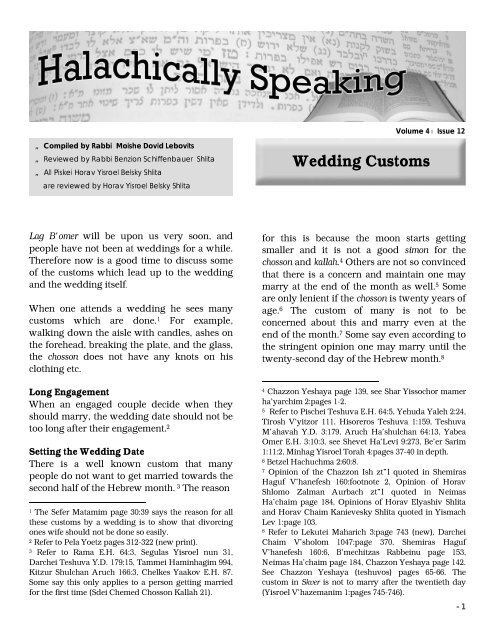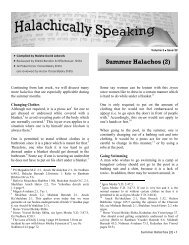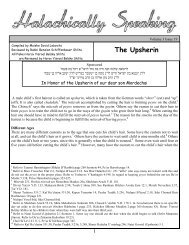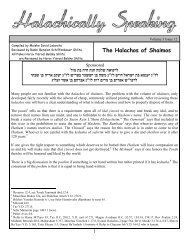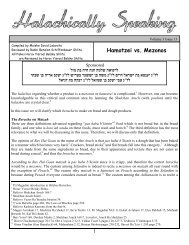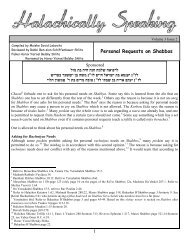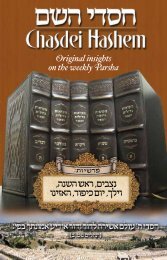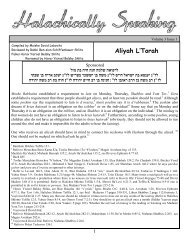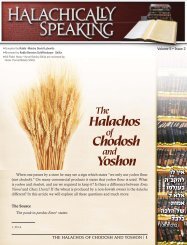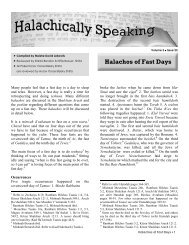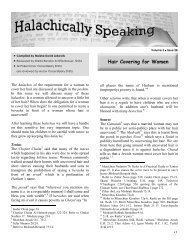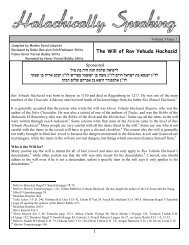Wedding Customs - Halachically Speaking
Wedding Customs - Halachically Speaking
Wedding Customs - Halachically Speaking
Create successful ePaper yourself
Turn your PDF publications into a flip-book with our unique Google optimized e-Paper software.
<strong>Halachically</strong> <strong>Speaking</strong><br />
Volume 4• Issue 12<br />
Compiled by Rabbi Moishe Dovid Lebovits<br />
Reviewed by Rabbi Benzion Schiffenbauer Shlita<br />
All Piskei Horav Yisroel Belsky Shlita<br />
are reviewed by Horav Yisroel Belsky Shlita<br />
<strong>Wedding</strong> <strong>Customs</strong><br />
Lag B'omer will be upon us very soon, and<br />
people have not been at weddings for a while.<br />
Therefore now is a good time to discuss some<br />
of the customs which lead up to the wedding<br />
and the wedding itself.<br />
When one attends a wedding he sees many<br />
customs which are done. 1 For example,<br />
walking down the aisle with candles, ashes on<br />
the forehead, breaking the plate, and the glass,<br />
the chosson does not have any knots on his<br />
clothing etc.<br />
Long Engagement<br />
When an engaged couple decide when they<br />
should marry, the wedding date should not be<br />
too long after their engagement. 2<br />
Setting the <strong>Wedding</strong> Date<br />
There is a well known custom that many<br />
people do not want to get married towards the<br />
second half of the Hebrew month. 3 The reason<br />
1 The Sefer Matamim page 30:39 says the reason for all<br />
these customs by a wedding is to show that divorcing<br />
ones wife should not be done so easily.<br />
2 Refer to Pela Yoetz pages 312-322 (new print).<br />
3 Refer to Rama E.H. 64:3, Segulas Yisroel nun 31,<br />
Darchei Teshuva Y.D. 179:15, Tammei Haminhagim 994,<br />
Kitzur Shulchan Aruch 166:3, Chelkes Yaakov E.H. 87.<br />
Some say this only applies to a person getting married<br />
for the first time (Sdei Chemed Chosson Kallah 21).<br />
for this is because the moon starts getting<br />
smaller and it is not a good simon for the<br />
chosson and kallah. 4 Others are not so convinced<br />
that there is a concern and maintain one may<br />
marry at the end of the month as well. 5 Some<br />
are only lenient if the chosson is twenty years of<br />
age. 6 The custom of many is not to be<br />
concerned about this and marry even at the<br />
end of the month. 7 Some say even according to<br />
the stringent opinion one may marry until the<br />
twenty-second day of the Hebrew month. 8<br />
4 Chazzon Yeshaya page 139, see Shar Yissochor mamer<br />
ha’yarchim 2:pages 1-2.<br />
5 Refer to Pischei Teshuva E.H. 64:5, Yehuda Yaleh 2:24,<br />
Tirosh V’yitzor 111, Hisoreros Teshuva 1:159, Teshuva<br />
M’ahavah Y.D. 3:179, Aruch Ha’shulchan 64:13, Yabea<br />
Omer E.H. 3:10:3, see Shevet Ha’Levi 9:273, Be’er Sarim<br />
1:11:2, Minhag Yisroel Torah 4:pages 37-40 in depth.<br />
6 Betzel Hachuchma 2:60:8.<br />
7 Opinion of the Chazzon Ish zt”l quoted in Shemiras<br />
Haguf V’hanefesh 160:footnote 2, Opinion of Horav<br />
Shlomo Zalman Aurbach zt”l quoted in Neimas<br />
Ha’chaim page 184, Opinions of Horav Elyashiv Shlita<br />
and Horav Chaim Kanievesky Shlita quoted in Yismach<br />
Lev 1:page 103.<br />
8 Refer to Lekutei Maharich 3:page 743 (new), Darchei<br />
Chaim V’sholom 1047:page 370, Shemiras Haguf<br />
V’hanefesh 160:6, B’mechitzas Rabbeinu page 153,<br />
Neimas Ha’chaim page 184, Chazzon Yeshaya page 142.<br />
See Chazzon Yeshaya (teshuvos) pages 65-66. The<br />
custom in Skver is not to marry after the twentieth day<br />
(Yisroel V’hazemanim 1:pages 745-746).<br />
- 1
<strong>Halachically</strong> <strong>Speaking</strong><br />
Others say that in the months of Elul, Tishrei<br />
and Adar there is no concern. 9 Although Lag<br />
B’omer is towards the end of the month making<br />
a wedding then is permitted and is not<br />
included in this inyun. The reason is because<br />
Lag B’omer is a day of joy and success. 10<br />
The Time between the Engagement and<br />
<strong>Wedding</strong><br />
Most people have the custom that from the<br />
week before the wedding the chosson and kallah<br />
do not communicate at all. 11 Many reasons are<br />
offered for this. Some say the reason is so it<br />
will enhance the joy for the wedding day. 12<br />
Inviting to a <strong>Wedding</strong><br />
Some bring down the custom for the chosson<br />
and kallah to go the cemetery to invite their<br />
non-living grandparents to the wedding. 13<br />
The Gemorah in Pesachim 14 says that if one who<br />
is called to attend a bris milah and does not go<br />
is excommunicated by Hashem. This halacha is<br />
brought in Shulchan Aruch as well. 15 Some<br />
poskim say that this inyun also applies to a<br />
seudas milah and to a seuda at the marriage of a<br />
daughter of a kohen to a talmid chachum only if<br />
9 Aruch Ha’shulchan E.H. 64:13, see Yisroel<br />
V’hazemanim 1:page 745:footnote 270. Regarding<br />
getting married during the month of Cheshvan see<br />
Orchos Rabbeinu 5:page 95:11.<br />
10 Sdei Chemed ibid:page 442.<br />
11 Emes L’Yaakov E.H. 64:footnote 32, Orchos Rabbeinu<br />
4:page 244:50, Soveh Smochos 1:6:1:footnote 1, Lev Ita<br />
page 4:9, Hachuppah V’hanesuin 1:page 72:footnote 5.<br />
The opinion of Horav Tuvia Goldstein zt”l was that one<br />
does not have to be concerned for this custom (Lev Ita<br />
page 4:footnote 11).<br />
12 The Eternal Bond page 68.<br />
13 Refer to Yesod V’shoresh Hu’avoda Shar Hakollel<br />
15:page 692 (new), Maharash Eingel 7:119:page 119,<br />
Yismach Lev 1:pages 54-55. Others do not have this<br />
custom (Derech Sicha 152).<br />
14 113b.<br />
15 Rama Y.D. 265:12, see Levush Minhagim (end of<br />
Orach Chaim ) 34.<br />
there are “good people” by the wedding. 16<br />
Based on this, the Pischei Teshuva 17 says it is not<br />
proper for a shamos to announced that<br />
everyone is invited to a bris because that would<br />
obligate all present to come. There is an<br />
opinion in the poskim who says that this is only<br />
referring to the following situation: The bris<br />
has just taken place and then the shamos<br />
announces that all are invited to the seuda of<br />
the bris. However, if one is invited on a<br />
different day then it is not a problem if he does<br />
not go. 18 Others say the inyun only applies to a<br />
seudas milah where everyone is eating and one<br />
does not want to partake in the seuda. 19 In any<br />
case one should not “invite” someone to a bris,<br />
and should say he is informing everyone about<br />
it. 20<br />
Many poskim say the custom is that this din is<br />
not extended to a wedding. 21 Many reasons are<br />
offered for this. Some say that a wedding is<br />
very long and one is not obligated to go and<br />
stay so long as opposed to a seudas bris which is<br />
much shorter. 22 Others say one who receives<br />
an invitation in the mail is not considered<br />
“invited” and does not have to partake in the<br />
wedding. 23 Some say it means if one is invited<br />
the day of the wedding. 24 Others maintain that<br />
since the ba’al simcha invites so many people<br />
because he has to, he does not really care if<br />
16 Tosfas Mesechtas Pesachim “v’ein.”<br />
17 Y.D. ibid:18. Refer to Otzer Haposkim E.H. 64:16:21.<br />
The Otzer Habris 3:17:5 says it is only talking if one is<br />
invited many times and does not go. Refer to Yabea<br />
Omer Y.D. 4:19:7 if a mohel who is a talmid chachum is<br />
included in this inyun if he chooses not to attend a bris<br />
to do the milah.<br />
18 Eretz Tzvi 2:page 407.<br />
19 Sefer Habris 265:167.<br />
20 Soveh Smochos 2:page 93:7, see Aruch Ha’shulchan<br />
ibid.<br />
21 Horav Yisroel Belsky Shlita, see Igros Moshe O.C. 2:95.<br />
22 Teshuvos V’hanhugos 2:649.<br />
23 Shulchan Haezer page 68a.<br />
24 Minhag Yisroel Torah 4:pages 98-100.<br />
- 2
<strong>Halachically</strong> <strong>Speaking</strong><br />
someone does not come. 25 Some say the reason<br />
is because sometimes there may be people who<br />
are not good by a wedding.<br />
Based on the aforementioned, one does not<br />
have to go to a wedding if he is invited.<br />
Nonetheless, the mitzvah to make a chosson and<br />
kallah happy still applies. 26<br />
Shemirah<br />
There is a known custom that the chosson and<br />
kallah require a special shemirah –watching<br />
before the wedding, 27 and they can not go<br />
around by themselves even in their own<br />
home. 28 Some say this inyun starts from after<br />
the Shabbos before the wedding, 29 while others<br />
say it is only the day of the wedding, 30 which<br />
starts from the night before. 31 A chosson who<br />
can not find himself a shomer to walk him to<br />
shul may go to shul without a shomer since<br />
many people walk in the streets. 32 Based on<br />
25 Yufei Leleiv Y.D. 265:22:page 89, Chazzon Yeshaya<br />
page 219. see Aruch Ha’shulchan Y.D 265:37, Chazzon<br />
Yeshaya page 350.<br />
26 Eretz Tzvi ibid.<br />
27 Mesechtas Berochos 54b, see Rama E.H. 64:1, Bais<br />
Shmuel 2, Be’er Heitiv 3, Magen Avraham O.C. 239:7,<br />
28 Aruch Ha’shulchan E.H. 64:3, Otzer Minhagei Nesuin<br />
page 34.<br />
29 Refer to Elya Rabbah O.C. 669:16, Edos L’Yisroel end<br />
of chapter 1:page 6, Halichos Shlomo Tefilla 5:footnote<br />
26, Emes L’Yaakov E.H. 64:footnote 32, Natei Gavriel<br />
Nesuin 1:page 55:5. Some say the kallah can go herself<br />
up until the day of the wedding (Emes L’Yaakov ibid).<br />
30 Refer to Shevet Ha’Levi 9:274:1, Opinion of the<br />
Chazzon Ish zt”l quoted in Mivakshei Torah 25:page<br />
292, and Massei Ish 5:page 25, Halichos Chaim 2:page<br />
162:footnote 294 who quotes the opinion of Horav<br />
Elyashiv Shlita that if the chuppah is after shekiah then no<br />
shomer is needed on the wedding day. Some say one<br />
should not send any letters between the chosson and<br />
kallah on the day of the chuppah (Opinion of Horav<br />
Elyashiv Shlita quoted in Mivakshei Torah 22:page 48).<br />
31 Opinion of Horav Tuvia Goldstein zt”l (Lev Ita page<br />
11:footnote 50). Some say it starts from the chuppah<br />
(opinion of Horav Elyashiv Shlita quoted in Yismach<br />
Lev 2:page 489:3, see ibid:page 512).<br />
32 Halichos Shlomo Tefilla 5:7, see Neimas Ha’chaim<br />
page 218.<br />
this some say if one lives in an area where<br />
there are always people in the street he does<br />
not need a shomer. 33 One is allowed to take a<br />
cab ride with a driver who is a goy and he is<br />
considered your shomer. 34<br />
Fasting the Day of the Chuppah<br />
The minhag is that a chosson and kallah fast on<br />
the day of their wedding. 35 Many reasons are<br />
given for this. Some say the reason is because it<br />
is a day of atonement for them. 36 Others say it<br />
is done to avoid becoming drunk and not<br />
having a clear mind at the time of the<br />
kiddushin. 37 Additionally, some people would<br />
fast before a very special mitzvah is performed,<br />
so a chosson and kallah fast before the important<br />
mitzvah of marriage. 38 A chosson on his<br />
wedding day is like a king, and since a king is<br />
judged every day, a chosson fasts. 39 Others say<br />
that the day of the chuppah is like Matan Torah,<br />
and the Bnei Yisroel fasted before they received<br />
the Torah. 40 One does not have to accept the<br />
fast upon himself the mincha before the fast. 41<br />
According to the reason that the chuppah is a<br />
day of atonement, if the chuppah is very late at<br />
night then one may break his fast after tzeis. If<br />
the chuppah is during the day, one should fast<br />
33 Opinion of Horav Wosner Shlita quoted in Lev Ita<br />
page 12:footnote 55, Neimas Ha’chaim page 219.<br />
34 Lev Ita page 1:27.<br />
35 Rama 562:2, E.H. 61:1, Birchei Yosef O.C. 470:2,<br />
Lekutei Maharich (Seder Hanhugos Yom Hachuppah)<br />
3:page 743 (new).<br />
36 Chai Adom 132:43, Mishnah Berurah 573:8, Yismach<br />
Lev 1:page 45. Refer to Taamei Haminhagim pages 402-<br />
403.<br />
37 Mahari Brunya 93, Be’er Heitiv 573:5, Kitzur Shulchan<br />
Aruch 146:3, Mishnah Berurah 573:8, Yismach Lev ibid,<br />
see Mivakshei Torah 27:page 39.<br />
38 Yismach Lev ibid, see Edos L’Yisroel page 74 for other<br />
reasons.<br />
39 Mahari Brunya 93.<br />
40 Yismach Lev ibid.<br />
41 Mishnah Berurah 562:11, Aruch Ha’shulchan E.H,<br />
61:21, Soveh Smochos 1:3:1, Be’er Moshe 3:78.<br />
- 3
<strong>Halachically</strong> <strong>Speaking</strong><br />
until after the chuppah. 42 Some places have the<br />
custom that only the chosson fasts, 43 and other<br />
places have the custom that both the chosson<br />
and kallah do not fast. 44 The overwhelming<br />
custom is that both the chosson and kallah fast. 45<br />
If the chosson or kallah are experiencing some<br />
difficulty with fasting they do not have to<br />
continue fasting. 46 Some places have the<br />
custom that the parents of the chosson and<br />
kallah also fast, 47 however, the custom of most<br />
people is not like this. 48 A chosson and kallah are<br />
permitted to brush their teeth and use<br />
mouthwash. 49 One who is not fasting should<br />
still not eat too much on the day of his<br />
wedding. 50<br />
42 Horav Yisroel Belsky Shlita. Horav Yaakov<br />
Kamenetsky zt”l said that one should not drink soda to<br />
break his fast on the day of his chuppah (As heard from<br />
Horav Yisroel Belsky Shlita). Refer to Kitzur Shulchan<br />
Aruch 146:1, Aruch Ha’shulchan E.H. 61:21, Chazzon<br />
Yeshaya page 231, see ibid:pages 236-237, Opinion of<br />
Horav Moshe Feinstein zt”l quoted in Rivevos Ephraim<br />
3:590:5.<br />
43 Taamei Haminhagim page 403. Refer to Hisoreros<br />
Teshuva E.H. 25.<br />
44 Refer to Knesses Hagedolah 559, Magen Avraham<br />
559:11, Yufei Leleiv 2:573, Sdei Chemed (Chosson<br />
Kallah) 4:page 15, Yabea Omer E.H. 3:9.<br />
45 Refer to Elya Rabbah 573:2, Shulchan Haezer 6:3:2,<br />
Edos L’Yisroel page 6. If the kallah fasted during the<br />
week of her chuppah some poskim are lenient with fasting<br />
on the day of the chuppah (Lev Ita page 21:footnote 45<br />
quoting the opinion of Horav Shlomo Zalman Aurbach<br />
zt”l, see Mivakshei Torah 27:page 41).<br />
46 Da’as Torah 573, Divrei Yatziv E.H. 5:72, Toras<br />
Yekose’al 2:92.<br />
47 Darchei Moshe 580.<br />
48 Horav Yisroel Belsky Shlita, see Yismach Lev 1:page<br />
46 quoting the opinion of Horav Elyashiv Shlita, Lev Ita<br />
page 17:footnote 1 quoting tthe opinion of Horav Tuvia<br />
Goldstein zt”l. Refer to Kinyan Torah 2:137:2.<br />
49 Lev Ita page 19:footnote 16 quoting the opinion of<br />
Horav Tuvia Goldstein zt”l.<br />
50 Bais Shmuel E.H. 61:6, Be’er Heitiv 573:5, Da’as Torah<br />
573.<br />
Tallis<br />
The custom is that on the day of the wedding<br />
the kallah has the tallis given to the chosson.<br />
Some do it even earlier. 51<br />
Kabbalas Panim<br />
The custom is that a kabbalas panim is made for<br />
the chosson. 52 Some have the custom that a<br />
badchan is also present in order to make the<br />
chosson happy for the wedding. 53<br />
At this time many have the custom to give a<br />
kevital to the chosson for him to daven under the<br />
chuppah. 54<br />
nayim<br />
The minhag is to break a plate at the t’nayim as<br />
a zecher l’churban. 55 The breaking should be<br />
done by any of the machatanim (usually the<br />
women). 56 The minhag is to break a complete<br />
plate. 57<br />
Badeken<br />
It is customary that the chosson is accompanied<br />
by his father, father in-law, family and friends<br />
to cover the face of the kallah. 58 The accepted<br />
custom is that the chosson himself covers the<br />
51 Taamei Haminhagim 947:page 405, Sefer Matamim<br />
chosson kallah 10-15:pages 41-43 (new), Minhag Yisroel<br />
Torah 4:pages 115-116.<br />
52 Edos L’Yisroel page 54, Shulchan Haezer 6:6, Minhag<br />
Yisroel Torah 4:pages 116-177.<br />
53 Taamei Haminhagim 955, Edos L’Yisroel pages 53-54,<br />
Minhag Yisroel Torah 4:pages 117-118. Others say there<br />
is no need for this (opinion of Horav Tuvia Goldstein<br />
zt”l quoted in Lev Ita page 35:footnote 5).<br />
54 Shulchan Haezer page 138.<br />
55 Malbushei Yom tov 560:1, Elya Rabbah 560:7, Sefer<br />
Matamim chosson v’kallah 8:page 41 (new), Mishnah<br />
Berurah 9, see Lekutei Maharich Nesuin page 741 (new).<br />
56 Sefer Matamim ibid, Shulchan Haezer 1:page 52,<br />
Lekutei Maharich ibid, Aruch Ha’shulchan 50:26, Piskei<br />
Teshuvos 560:footnote 52.<br />
57 Pri Megadim M.Z. 4, Lekutei Maharich ibid, see<br />
Miyum Hahalacha 2:76.<br />
58 Rama E.H. 31:2, Minhag Yisroel Torah 4:pages 138-<br />
139, see Mesechtas Kesubos 17b. Refer to Drisha 65:1.<br />
- 4
<strong>Halachically</strong> <strong>Speaking</strong><br />
kallah’s face with a veil. 59 Many others such as<br />
the fathers and grandfathers 60 cover the kallah’s<br />
face as well. 61 This is done right before the<br />
chuppah. 62 Some consider this to be the actual<br />
chuppah. 63 Others say the kallah conceals her<br />
face as if to say that she is not interested in a<br />
different man-only her chosson. 64 While others<br />
say it is done to show that we are not looking<br />
at her beauty only at her deeds and family. 65<br />
The face of the kallah is not revealed until after<br />
the chuppah. 66 Many use a see-through veil. 67<br />
Preparing for the Chuppah<br />
The custom is that the parents of the chosson<br />
and kallah both bentch their children before<br />
walking down to the chuppah. 68<br />
The chosson wears a white kittel to the<br />
chuppah. 69 Some say the reason is because<br />
white resembles the day of death and it will<br />
cause the chosson to do teshuva. 70 The chosson<br />
has the kittel placed on him by someone else. 71<br />
The custom is that one wears a different<br />
garment on top of the kittel. 72 One should not<br />
place his left sleeve in the coat as a deviation<br />
from the normal way of wearing it; this is to<br />
remember the day of death since this is the<br />
custom of an avel. 73<br />
Ashes on the Forehead<br />
Before going to the chuppah, 74 ashes are placed<br />
on the chosson’s forehead 75 in the place where<br />
the tefillin are put on 76 and the chosson should<br />
say im eshkacheich… 77 Although some say the<br />
custom is to remove the ashes immediately<br />
after putting them on, 78 it seems that most<br />
people leave the ashes on the chosson’s<br />
forehead. Some say that the kallah also gets<br />
ashes placed on her forehead. 79 Some people<br />
do either the placing of the ashes or the<br />
59 Refer to Rama E.H. 55:1, Aruch Ha’shulchan E.H.<br />
55:10, 64:17, Taamei Haminhagim 950:page 405, Edos<br />
L’Yisroel page 56:4, Teshuvos V’hanhugos 3:393, Mesora<br />
8:page 53:12, Orchos Rabbeinu 5:page 12:29.<br />
60 The Steipler zt”l did not cover the face of the kallah<br />
(Orchos Rabbeinu 5:pages 11-12:29).<br />
61 See Shulchan Hatohar 7:1:5, Kitzur Shulchan Aruch<br />
147:3.<br />
62 In earlier years it was done the morning of the<br />
wedding (Opinion of Horav Tuvia Goldstein zt”l quoted<br />
in Lev Ita page 51:footnote 4).<br />
63 Rama E.H. 55:1, Bach 61.<br />
64 Sefer Matamim chosson v’kallah 53:50 page 50 (new).<br />
65 Ibid:55.<br />
66 Sefer Matamim chosson v’kallah 83:page 54 (new),<br />
Chazzon Yeshaya page 287:3.<br />
67 Lev Ita page 53:footnote 15.<br />
68 Kitzur Shulchan Aruch 147:4, Shulchan Ha’ezer 2:page<br />
27, Edos L’Yisroel page 58:6, Lev Ita page 54, see Sefer<br />
Matamim chosson v’kallah 138. In regard to using one or<br />
two hands see Mivakshei Torah 27:pages 54-55.<br />
69 Kitzur Shulchan Aruch 147:4, Shulchan Haezer 2:page<br />
27, Pri Hasadeh 4:97, Chazzon Yeshaya page 289, see<br />
Orchos Rabbeinu 5:page 10:27. Some did not have the<br />
custom to wear a kittel to the chuppah (Custom of the<br />
Steipler zt”l and Horav Chaim Kanievesky Shlita as<br />
stated in Orchos Rabbeinu ibid).<br />
70 Sefer Matamim chosson v’kallah 85:page 54 (new),<br />
Chazzon Yeshaya page 289, Minhag Yisroel Torah<br />
4:page 151.<br />
71 Kitzur Shulchan Aruch 147:4, Minhag Yisroel Torah<br />
4:page 129, Yismach Lev 1:page 75, Otzer Minhagei<br />
Nesuin page 71, Rivevos Ephraim 4:224:5, Chazzon<br />
Yeshaya page 289:4. The reason is because it is just like<br />
by death that one is dressed by others (Chazzon Yeshaya<br />
ibid).<br />
72 Lev Ita page 55:4, Yismach Lev 1:page 75.<br />
73 Minhag Yisroel Torah 4:page 154, Lev Ita page 55,<br />
Natei Gavriel Nesuin page 116:footnote 7.<br />
74 Chazzon Yeshaya page 290:5. Some say one should<br />
place the ashes in a paper bag because of the honor of<br />
the chosson (Horav Shlomo Zalman Aurbach zt”l quoted<br />
in Mivakshei Torah 26:page 391:32). Others place ashes<br />
before the badeken (Opinion of Horav Elyashiv Shlita<br />
quoted in Mivakshei Torah 29:page 172).<br />
75 Rambam Hilchos Taanis 5:13, Shulchan Aruch E.H.<br />
65:3, Aruch Ha’shulchan E.H. 65:5, Edos L’Yisroel page<br />
57. Someone else places it on his forehead (Al Pi Hatorah<br />
Bereishis page 559). Refer to B’shivili Haminhag 2:page<br />
137, see Yismach Lev 1:page 76.<br />
76 Siddur Yaavetz 2:page 224:7.<br />
77 Taz E.H. 65:4.<br />
78 Refer to Shulchan Haezer 7:1:11, see Aruch<br />
Ha’shulchan O.C. 560:6.<br />
79 Taamei Haminhagim page 407.<br />
- 5
<strong>Halachically</strong> <strong>Speaking</strong><br />
breaking of the glass (see below), 80 however,<br />
the custom of most people is to do both. 81<br />
Emptying Pockets and Untying Knots<br />
Some say since the chuppah is a time when one<br />
remembers the day of death and does teshuva,<br />
one should empty his pockets to remember<br />
that just as by death one does not take<br />
anything with him so too by the chuppah one<br />
does not take anything. 82 Some say the reason<br />
is to show that we accept the chosson and kallah<br />
for what they are and not for what they wear. 83<br />
The custom is to undo the knots of one’s shoe<br />
and undo his tie. 84<br />
Some think that by giving away one’s personal<br />
belongings to his friend etc before going to the<br />
chuppah it is some sort of segula. In reality, there<br />
is no such segula, and if one chooses do to so he<br />
may since they will make sure that it is<br />
watched properly. 85<br />
Walking Down the Aisle<br />
At the wedding of Adom and Chavah two<br />
angels escorted them. 86 From this comes the<br />
custom that two people escort the chosson and<br />
kallah. 87 The reason is since a chosson is a king,<br />
and a king has an escort. 88<br />
There is a discussion in the poskim if the fathers<br />
of both sides should walk down the chosson<br />
and the mothers should walk down the kallah,<br />
or the parents of the chosson walk down the<br />
chosson and the parents of the kallah walk down<br />
the kallah.<br />
Many have the custom that the fathers of both<br />
sides walk down the chosson and the mothers<br />
walk down the kallah. 89 However, others have<br />
the custom that the parents of the chosson and<br />
kallah walk their child down the aisle. 90<br />
Some have the custom that a pregnant woman<br />
should not walk down the aisle if it is<br />
recognizable that she is pregnant, since there is<br />
80 Bais Yosef E.H. 65, Chai Adom 137:2, Aruch<br />
Ha’shulchan 6, Kaf Ha’chaim 560:21, Lev Ita page<br />
52:footnote 27, see Minhag Yisroel Torah 4:page 150.<br />
Refer to Kaf Ha’chaim 18.<br />
81 Lev Ita page 52.<br />
82 Refer to Taamei Haminhagim 951:page 406, Shulchan<br />
Ha’ezer 2:page 136, Chai Ha’levi 4:91:19, Minhag<br />
Yisroel Torah 4:pages 153-154, Mivakshei Torah 29:page<br />
173, Chazzon Yeshaya page 291:8, Natei Gavriel page<br />
117:5. Some say this is the custom in Yerushalayim not in<br />
Chutz L’aretz (Opinion of Horav Shach zt”l quoted in<br />
Neimas Ha’chaim page 279). Others say there is no<br />
custom like this (opinion of Horav Elyashiv Shlita<br />
quoted in Yismach Lev 1:page 77). Some say taking off<br />
the watch is not required (Opinion of Horav Shlomo<br />
Zalman Aurbach zt”l quoted in Mivakshei Torah<br />
27:page 11).<br />
83 The Eternal Bond page 95, see Refer to Sefer Matamim<br />
chosson v’kallah 78:page 53 (new), Mivakshei Torah<br />
29:page 174.<br />
84 Refer to Lev Ita page 55:5.<br />
85 Horav Yisroel Belsky Shlita.<br />
86 Sefer Matamim page 54:87 (new), see Edos L’Yisroel<br />
pages 58-59, Mivakshei Torah 27:page 63.<br />
87 Refer to Kitzur Shulchan Aruch 147:5, Minhag Yisroel<br />
Torah 4:pages 126-127, Chazzon Yeshaya page 245, Lev<br />
Ita page 57.<br />
88 Tashbeitz Hakotton 465.<br />
89 Refer to Rama Y.D. 391:3, Levushei Mordechai 3:22:2,<br />
Bais Avi 5:140, , Chazzon Yeshaya page 246, custom of<br />
Horav Shlomo Zalman Aurbach zt”l and Horav<br />
Elyashiv Shlita (Mivakshei Torah 27:page 65), see Edos<br />
L’Yisroel page 58, Minhag Yisroel Torah 4:pages 128-129.<br />
If conflicting customs arise one should consult his Rav.<br />
(Refer to Be’er Moshe 3:184, 5:165, Mivakshei Torah<br />
27:page 64).<br />
90 Refer to Bais Avi, 5:140, Minchas Osher 1:133, Shevet<br />
Ha’Levi 3:187, Edos L’Yisroel 8:7:pages 58-59. Opinions<br />
of Horav Moshe Feinstein zt”l and Horav Tuvia<br />
Goldstein zt”l (As quoted in Lev Ita page 59:footnote 24),<br />
see Mivakshei Torah 27:page 65, Yismach Lev 1:page 73.<br />
The father walks on the right and the mother on the left<br />
(Horav Elyashiv Shlita quoted in Mivakshei Torah<br />
27:page 66).<br />
- 6
<strong>Halachically</strong> <strong>Speaking</strong><br />
an ayin hara. 91 Others are not concerned with<br />
this.<br />
Some poskim say it is not advisable for a couple<br />
who are married for the second time to walk<br />
down their children (from the first marriage). 92<br />
Many have the custom that the chosson steps<br />
forward when the kallah approaches the<br />
chuppah. 93<br />
Walking to the Chuppah<br />
The chosson walks down to the chuppah first. 94<br />
Some say this is learned from the fact that<br />
Hashem took Chavah and brought her to Adam. 95<br />
The chosson and kallah should walk with their<br />
right foot first. 96 The father is on the right side<br />
and the mother on the left. 97<br />
Candles<br />
The ones escorting the chosson and kallah walk<br />
down with lit candles. 98 Some say the light is to<br />
show joy and happiness. However, the custom<br />
quoted in most of the seforim is because ner is<br />
equal to 250 and two neros (candles) equals 500<br />
which equals to the amount of limbs in both a<br />
man (248) and a woman (252). 99<br />
Others say a wedding is like the giving of the<br />
Torah, and since the giving of the Torah was<br />
with fire so too the wedding (chuppah) is done<br />
with fire. 100<br />
Chuppah in a Shul / Indoors<br />
The custom is to have a chuppah either<br />
outdoors or indoors under an open sky. 101 The<br />
reason for this is a siman tov for one to have “as<br />
many children as the number of the stars in the<br />
sky.” 102 The custom is to open the roof at an<br />
indoor chuppah for it to be considered under<br />
the sky. 103 The Sefardim do not perform their<br />
chuppahs under an open sky. 104 There is a major<br />
discussion in the poskim whether one is<br />
allowed to have a chuppah in a shul, or in any<br />
closed area, since it may seem that one is<br />
following in the ways of the goyim, who<br />
perform their weddings indoors in their<br />
churches. 105 Horav Moshe Feinstein zt”l 106 is of<br />
the opinion that there is no problem with<br />
performing a chuppah in a shul since it is<br />
91 Shearim Metzuyanim B’halacha 147:12, Be’er Moshe<br />
3:184:4, Chazzon Yeshaya page 247, Opinion of Horav<br />
Chaim Kanievesky Shlita quoted in Yismach Lev 1:page<br />
74, Natei Gavriel Nesuin page 112:footnote 27.<br />
92 Refer to Teshuvos V’hanhugos 2:652, Be’er Moshe<br />
3:184, Lehoros Nosson 2:98, Chelkes Yaakov 3:76, Levi<br />
Ita page 58:5.<br />
93 Refer to Taz E.H. 65:2, Kitzur Shulchan Aruch 147:5,<br />
Shulchan Ha’ezer 7:4:7.<br />
94 Refer to Kitzur Shulchan Aruch 147:5, Edos L’Yisroel<br />
page 60:9, Yismach Lev 1:page 76-77, Ha’nesuin<br />
K’hilchosom 12:57, Lev Ita page 58:9.<br />
95 Sefer Matamim chosson v’kallah 48:page 32 (new),<br />
Shulchan Haezer 7:4:3.<br />
96 Shulchan Ha’ezer 2:page 31, Sefer Matamim chosson<br />
v’kallah 141:page 62 (new), Yismach Lev 1:page 77,<br />
Minhag Yisroel Torah 4:page 169.<br />
97 Levi Ita page 59:10.<br />
98 Rokeach 353, Edos L’Yisroel page 60. Some say not to<br />
extinguish the candles until the end of the chuppah<br />
(Mivakshei Torah 27:page 70). The custom is not like<br />
this.<br />
99 Sefer Matamim page 25:16 (new), Mivakshei Torah<br />
27:page 70, see Sefer Matamim page 55:89-90, Yismach<br />
Lev 1:page 81.<br />
100 Taamei Haminhagim 960:page 407, see Sefer<br />
Matamim chosson v’kallah 16.<br />
101 Rama E.H. 61:1, Bais Shmuel E.H. 30:9, Chassam Sofer<br />
E.H 98, Aruch Ha’shulchan E.H. 61:21, Otzar Haposkim<br />
61:14:1, Edos L’Yisroel pages 23-24, Mivakshei Torah<br />
29:pages 154-159, Chazzon Yeshaya page 280.<br />
102 Rama ibid. Refer to Sdei Chemed Chassan V’Kallah<br />
1:pages 11-13, see Yismach Lev 1:page 82 for other<br />
reasons.<br />
103 Chazzon Yeshaya page 281, see Mivakshei Torah<br />
29:page 159.<br />
104 Yaskil Avdi E.H. 6:1, Yismach Lev 1:page 82:122.<br />
105 Refer to Levushei Mordechai E.H. 1:47, Divrei Malkiel<br />
5:205, Maharam Shik E.H. 87, Yehuda Yaleh 1:38,<br />
Chassam Sofer E.H. 85, Pri Hasadeh 4:97, Mishpatei<br />
Uziel E.H. 60, Yaskil Avdi E.H. 7:10, Yabea Omer E.H.<br />
3:10, Teshuvos V’hanhugos 2:648, Yismach Lev 1:page<br />
83, B’shvili Haparsha pages 340-341.<br />
106 E.H. 1:93, see Mesora 8:page 52:6.<br />
- 7
<strong>Halachically</strong> <strong>Speaking</strong><br />
obvious that one is not doing this to follow in<br />
the ways of the goyim. 107<br />
Standing by the Chuppah<br />
Although many poskim maintain that those<br />
present at the chuppah should stand during the<br />
entire chuppah, 108 the custom does not seem to<br />
be like this. 109 There are many reasons offered<br />
as to why we stand during the chuppah. Some<br />
say since the chosson is doing a mitzvah by<br />
getting married we stand in that honor. 110 It is<br />
customary to stand when the chosson and kallah<br />
walk down the aisle. Some say this is out of<br />
respect for the chosson and kallah. 111<br />
Circling the Chosson<br />
After the kallah walks down to the chuppah she<br />
circles the chosson (together with the two<br />
mothers). 112 Some say the reason is because<br />
whoever lives without a wife lives without a<br />
“wall,” 113 so the kallah walks around the<br />
chosson to symbolize that she will shield him<br />
like a wall from temptation. 114 Some have the<br />
107 It is therefore permitted for a mesader kedushin to<br />
perform a kiddushin in a shul (Igros Moshe ibid).<br />
Nonetheless, a chuppah should not be made in a shul for<br />
other reasons. (Yalkut Yosef (Soveh Simchas) 1:pages 90-<br />
91, Yismach Lev 1:page 83:124).<br />
108 Knesses Hagedolah E.H. 62, Orchos Chaim Hilchos<br />
Kiddushin 2:page 66, Ha’elef Lecha Shlomo E.H. 115,<br />
Edos L’Yisroel page 63, Yugel Yaakov page 109,<br />
Yismach Lev 1:page 90, Yabea Omer E.H. 6:8.<br />
109 Opinion of Horav Elyashiv Shlita quoted in Yugel<br />
Yaakov page 110:footnote 178, see Yismach Lev 1:pages<br />
90 and 367 who quotes the opinion of Horav Chaim<br />
Kanievesky Shlita who says that one only needs to stand<br />
if he is close to the chuppah. Horav Moshe Feinstein zt”l<br />
did not stand, while Horav Yaakov Kamenetsky zt”l<br />
stood (Horav Yisroel Belsky Shlita Yismach Lev ibid and<br />
page 91). Refer to Shearim Metzuyanim B’halacha 147:13<br />
(kuntres achron) who says the custom is to be lenient<br />
since the chuppah is in its own reshus.<br />
110 Opinion of Horav Yisroel Belsky Shlita quoted in<br />
Yismach Lev 1:page 91:135, page 498.<br />
111 Refer to Knesses Hagedolah E.H. 62.<br />
112 Orchos Rabbeinu 5:page 13:31-32.<br />
113 Mesechtas Yevomos 62b.<br />
114 The Eternal Bond page 109.<br />
custom to circle three times, 115 while others<br />
have the custom to circle seven times. 116 The<br />
overwhelming custom is to do it seven<br />
times. 117 One of the reasons for circling three<br />
times is alluding to the three times it says in<br />
the Torah that a man should take a wife. 118<br />
Others say the reason is to allude to the three<br />
times when a man is paired with his wife. The<br />
first is when the kol (voice) go outs from<br />
shomayim forty days before the creation of a<br />
fetus that the two are destined for each other.<br />
The second is under the chuppah, and the third<br />
time is in olom haba. 119 One of the reasons for<br />
walking around seven times is to represent the<br />
seven days of creation, which emphasizes that<br />
a chosson and kallah are now creating a<br />
miniature world of their own. 120<br />
After the kallah circles the chosson she stands on<br />
the right side of the chosson. 121<br />
Crowns<br />
Both the chosson and kallah do not wear crowns<br />
by the chasuna as a zecher l’churban. 122 The<br />
Aruch Ha’shulchan 123 says he is not sure what<br />
crowns this is referring to.<br />
115 Refer to Sefer Matamim page 53:79 (new), Edos<br />
L’Yisroel page 61, Yismach Lev 1:page 89, Mivakshei<br />
Torah 29:page 177.<br />
116 Kitzur Shulchan Aruch 147:5.<br />
117 Lev Ita page 61:18. This is the custom in Yerushalayim<br />
as well as other places (Mivakshei Torah 29:page 177).<br />
118 The Eternal Bond page 111.<br />
119 The Eternal Bond page 112, see Edos L’Yisroel page<br />
61.<br />
120 The Eternal Bond page 110.<br />
121 Rokeach 353, Yufei Leleiv 4:page 61, Rivevos Ephraim<br />
4:224:3. Refer to Taamei Haminhagim 963:page 408,<br />
Mivakshei Torah 29:page 178. Many places have the<br />
custom to face east (Kitzur Shulchan Aruch 147:5, Aruch<br />
Ha’shulchan E.H. 62:9). If the wedding is in Yerushalayim<br />
the chosson and kallah face the mokom hamikdosh (Opinion<br />
of Horav Elyashiv Shlita quoted in Yismach Lev 1:page<br />
189).<br />
122 Shulchan Aruch 560:4, Pri Megadim M.Z. 6, Mishnah<br />
Berurah 17.<br />
123 560:8.<br />
- 8
<strong>Halachically</strong> <strong>Speaking</strong><br />
Breaking a Glass under the Chuppah<br />
The custom is that the chosson 124 breaks a<br />
glass 125 under the chuppah 126 as a zecher<br />
l’churban. 127 The glass is broken with the right<br />
foot. 128 The reason why the chosson breaks the<br />
glass now and not the plate at the t’nayim, is<br />
because at the t’nayim his simcha is not yet<br />
complete. 129 The glass is wrapped in a napkin<br />
in order to prevent the chosson from hurting his<br />
foot. 130 There is no concern of b’al tashchis with<br />
breaking the glass because it is being done for<br />
mitzvah purposes. 131 The seforim mention why a<br />
glass is broken by the chuppah, and a plate<br />
(earthernware) at the t’nayim. 132<br />
The glass is broken after the sheva berochos are<br />
recited. 133 Today, many people sing im<br />
eshkacheich… before breaking the glass. Some<br />
poskim maintain that mazel tov should not be<br />
said immediately after the glass is broken<br />
because one is supposed to be remembering<br />
the churban at that time. 134 Nevertheless, the<br />
minhag is to say mazel tov immediately after<br />
breaking the glass. 135<br />
124 Rokeach ibid, Shulchan Aruch E.H. 65:3, Rama, Sdei<br />
Chemed 7:12:page 462, Aruch Ha’shulchan ibid.<br />
125 Tosfas Mesechtas Berochos 31a “eisay,” Rokeach 353,<br />
Sharei Teshuva 560, Shulchan Govah 560:5, Shulchan<br />
Haezer 2:page 49, Sefer Matamim page 41 (new), Lekutei<br />
Maharich page 742 (new). Refer to Maharsha Berochos<br />
page 12 why glass is used. Also see Kovetz Mivakshei<br />
Torah 33-34:page 100-101. The custom is to use a glass<br />
that a beracha was not made on (Refer to Pri Megadim<br />
M.Z. 560:4, Lekutei Maharich Nesuin, Shulchan Haezer<br />
2:page 49, Kovetz Mivakshei Torah ibid:page 101).<br />
126 Kol Bo 62, Rama 560:2, Rama E.H. 65:3, Ben Ish Chai<br />
Shoftim 1:11, Aruch Ha’shulchan E.H. 65:5.<br />
127 Meiri Mesechtas Taanis 30b. Other reasons for this are<br />
offered by the poskim (Refer to Mesechtas Berochos 30b-<br />
31a, Maharsha, Sefer Matamim Hachodesh chosson<br />
v’kalah 34, Kovetz Mivakshei Torah 33-34:pages 94-97).<br />
128 Shulchan Haezer 2:page 50:24, Lev Ita page 82:2,<br />
Chazzon Yeshaya page 331. Although some say the<br />
chosson should throw the cup at the wall (Maharil<br />
Nesuin page 467), this is not the custom (Nesuin<br />
K’hilchosom 12:footnote 187).<br />
129 Sefer Matamim page 41 (new), Sefer Matamim<br />
Ha’chodesh chosson v’kallah 5.<br />
130 Shulchan Haezer 2:page 50, Minhag Yisroel Torah<br />
4:page 187.<br />
131 Pri Megadim M.Z. 4, Ben Yehoyuda Mesechtas<br />
Berochos 31a, Mishnah Berurah 9, Aruch Ha’shulchan<br />
E.H. 65:5, Mivakshei Torah 25:pages 239-243 in depth.<br />
Some take a broken glass (Eitz Hasadeh page<br />
149:footnote 15).<br />
132 Refer to Yabea Omer E.H. 4:9, see Edos L’Yisroel page<br />
37, Orchos Rabbeinu 5:page 6:15.<br />
133 Rama E.H. 65:3, Pri Megadim M.Z. O.C. 560:4, Sdei<br />
Chemed Chosson V’kallah 2:page 13, Aruch<br />
Ha’shulchan E.H. 65:5, Shulchan Haezer 2:page 51, Edos<br />
L’Yisroel page 36, Lev Ita page 81, Chai Ha’Levi 4:91:23,<br />
Opinion of Horav Chaim Kanievesky Shlita quoted in<br />
Yismach Lev 1:page 158. Refer to Yismach Lev 1:page 49<br />
who brings opinions who hold to break it before the<br />
reading of the kesuba. Refer to Pri Megadim M.Z. 560:4,<br />
Teshuvos V’hanhugos 4:286:3. The custom in<br />
Yerushalayim is to break the glass after the birchos erusin<br />
(Kovetz Mivakshei Torah 33-34:page 98). It is also the<br />
custom of Skver, Vishnitz and Munkatch (Natei Gavriel<br />
Nesuin 26:footnote 3, Lev Ita page 75:footnote 1).<br />
134 Refer to Shulchan Haezer 1:page 52:26, Edos L’Yisroel<br />
page 64:8, Chai Ha’Levi 4:91:23, Teshuvos V’hanhugos<br />
4:286:3. Others are lenient with this (Eitz Hasadeh page<br />
148:footnote 12 quoting the opinion of Horav Shlomo<br />
Zalman Aurbach zt”l, see Yismach Lev 1:page 159).<br />
135 Refer to Shulchan Haezer 2:page 50, Kovetz<br />
Mivakshei Torah 26:page 392:44 quoting the opinion of<br />
Horav Shlomo Zalman Aurbach zt’’l, 33-34:page 103,<br />
Yabea Omer E.H. 4:9. In regard to throwing confetti after<br />
the chuppah see Yismach Lev 1:pages 80-81, Mivakshei<br />
Torah 27:pages 78-79.<br />
- 9
<strong>Halachically</strong> <strong>Speaking</strong><br />
In Honor of the<br />
Upcoming Marriage of<br />
Yitty Neuhauser and<br />
Binyomin Basch<br />
-Sponsored-<br />
-Sponsored-<br />
<br />
<br />
<br />
<br />
-Sponsored-<br />
<br />
<br />
<br />
<br />
<strong>Halachically</strong> <strong>Speaking</strong><br />
<strong>Halachically</strong> <strong>Speaking</strong> is a bi-weekly<br />
publication compiled by Rabbi Moishe<br />
Dovid Lebovits, a former chaver kollel of<br />
Yeshiva Torah Vodaath and a musmach<br />
of Horav Yisroel Belsky Shlita. Rabbi<br />
Lebovits currently works as the<br />
Rabbinical Administrator for the KOF-K<br />
Kosher Supervision.<br />
Each issue reviews a different area of<br />
contemporary halacha with an emphasis<br />
on practical applications of the principles<br />
discussed. Significant time is spent<br />
ensuring the inclusion of all relevant<br />
shittos on each topic, as well as the psak<br />
of Horav Yisroel Belsky, shlita on current<br />
issues.<br />
Sponsorship Opportunities<br />
<strong>Halachically</strong> <strong>Speaking</strong> is distributed<br />
to over 40 shuls in Brooklyn reaching<br />
over 1000 readers on a weekly basis, and<br />
is sent via email to subscribers across<br />
the country. Your generous sponsorship<br />
will enable us to expand the scope of this<br />
project. For more information on<br />
sponsorship opportunities please call:<br />
718.744.4360, or send an email to<br />
mdl@thehalacha.com.<br />
Affiliated with:<br />
© Copyright 2008 by <strong>Halachically</strong> <strong>Speaking</strong><br />
All rights reserved.<br />
- 10


